![]()
Contents: #17 Cl, #24 Cr, #55 Cs, #53 I, #49 In, #77 Ir, #45 Rh, #37 Rb, #81 Tl
 The four Siberian Beresof gold mines had been worked for gold, copper, silver and lead since 1752. Small amounts of a red mineral were obtained accompanying lead ore. Johann Gottlob Lehmann investigated this mineral known as crocoite or crocoisite in 1766 and found it produced an emerald-green solution when dissolved in muriatic acid. He died the next year when a retort containing arsenic burst upon heating. In 1797 Nicolas-Louis Vauquelin (1763-1829 shown at left), noting its beauty, scarcity, value equal to gold, and several contradictory chemical analyses, determined to find the correct composition of crocoite. Vauquelin was born to a farm laborer in Normandy, made rapid progress in school, and at age 14 became a dishwasher and assistant in an apothecary. He went to Paris with a letter of introduction and worked for several apothecary shops. One pharmacy was owned by a cousin of the chemist, Fourcroy. Hearing of Vauquelin's interest in chemistry, Fourcroy hired the boy as his assistant. Vauquelin lived with Fourcroy and his unmarried sisters who provided motherly care. Vauquelin continued to rapidly learn physics, chemistry and philosophy while assisting Fourcroy with chemistry and the teaching of Fourcroy's students. Because of the French Revolution, Vauquelin left Paris in 1793, served as pharmacist in a military hospital, then returned to teach chemistry at the Central School of Public Works which later became the École Polytechnique. Vauquelin boiled pulverized crocoite with two parts potash obtaining a yellow solution. The solution formed a beautiful red precipitate with a mercury salt, and a yellow precipitate with lead. Adding tin muriatic turned the solution green. In 1798 he precipitated lead with muriatic acid, dried the green solid, then cooked it for half an hour in a charcoal crucible with charcoal dust. Upon cooling he discovered a network or gray, metallic needles weighing 1/3 the original. Because of the many colors of its compounds, Fourcroy and Haüy suggested the name Chromium(Cr = #24): Khroma (Greek) for color. Vauquelin later became inspector of mines and professor of assaying at the School of Mines where he continued to live under the care of the Fourcroy sisters until their deaths. Vauquelin, and Klaproth in Germany, became the top analytical chemists of their day.
The four Siberian Beresof gold mines had been worked for gold, copper, silver and lead since 1752. Small amounts of a red mineral were obtained accompanying lead ore. Johann Gottlob Lehmann investigated this mineral known as crocoite or crocoisite in 1766 and found it produced an emerald-green solution when dissolved in muriatic acid. He died the next year when a retort containing arsenic burst upon heating. In 1797 Nicolas-Louis Vauquelin (1763-1829 shown at left), noting its beauty, scarcity, value equal to gold, and several contradictory chemical analyses, determined to find the correct composition of crocoite. Vauquelin was born to a farm laborer in Normandy, made rapid progress in school, and at age 14 became a dishwasher and assistant in an apothecary. He went to Paris with a letter of introduction and worked for several apothecary shops. One pharmacy was owned by a cousin of the chemist, Fourcroy. Hearing of Vauquelin's interest in chemistry, Fourcroy hired the boy as his assistant. Vauquelin lived with Fourcroy and his unmarried sisters who provided motherly care. Vauquelin continued to rapidly learn physics, chemistry and philosophy while assisting Fourcroy with chemistry and the teaching of Fourcroy's students. Because of the French Revolution, Vauquelin left Paris in 1793, served as pharmacist in a military hospital, then returned to teach chemistry at the Central School of Public Works which later became the École Polytechnique. Vauquelin boiled pulverized crocoite with two parts potash obtaining a yellow solution. The solution formed a beautiful red precipitate with a mercury salt, and a yellow precipitate with lead. Adding tin muriatic turned the solution green. In 1798 he precipitated lead with muriatic acid, dried the green solid, then cooked it for half an hour in a charcoal crucible with charcoal dust. Upon cooling he discovered a network or gray, metallic needles weighing 1/3 the original. Because of the many colors of its compounds, Fourcroy and Haüy suggested the name Chromium(Cr = #24): Khroma (Greek) for color. Vauquelin later became inspector of mines and professor of assaying at the School of Mines where he continued to live under the care of the Fourcroy sisters until their deaths. Vauquelin, and Klaproth in Germany, became the top analytical chemists of their day. 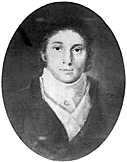
Pyrolusite was a half mineral
which had been used for centuries to give a violet color to glass and pottery. Bergman thought the mineral, also called magnesia nigri, was the calx of a metal but he was unable to isolate the metal. Bergman suggested the problem to his friend Carl Scheele (1742-1786 shown at right) who in 1774 reported three years of experiments on pyrolusite. Among other discoveries, he noted that when he let finely ground pyrolusite (MnO2) stand with the spiritus salis (also called muriatic acid) it produced a suffocating odor like warm aqua regia, most oppressive to the lungs. He noticed that this air dissolved slightly in water, imparted an acid taste, bleached flowers and leaves, and attacked all metals. Like most chemists of the time, Scheele subscribed to the phlogiston theory which attempted to explain chemical reactions. Believing that pyrolusite had removed phlogiston from muriatic acid, Scheele named this air dephlogisticated muriatic acid. Meanwhile in Paris a friend of Fourcroy and Vauquelin, Antoine Lavoisier, proposed to replace both the four element theory and phlogiston with numerous new elements and a concept of combustion involving a new gaseous element. Lavoisier named the gas responsible for combustion oxygen, meaning acid forming,
because all compounds containing oxygen seemed to be acidic. Claude Berthollet, a colleague of Lavoisier, therefore proposed that Scheele's dephlogisticated muriatic acid gas must be a combination of oxygen and an undiscovered element, muriaticum. In 1808 Humphry Davy decomposed muriatic acid with potassium producing hydrogen and potassium chloride. After other attempts to release oxygen failed, Davy concluded that dephlogisticated muriatic acid gas was actually an element rather that a compound with oxygen. Davy proposed the name Chlorine (Cl = #17): Khloros (Greek) for yellow green because the gas is that color. muriatic acid (HCl), lacking any oxygen, would require a new explanation for acidic properties. Because many oxides are in fact acidic, discarding the explanation that oxygen causes acidic properties was unreasonable for many chemists.
Iodine was discovered by Bernard Courtois (1777-1838) who learned the manufacture of saltpeter from his father. After an apprenticeship as a pharmacist, Bernard joined his father's business. Fucus and other brown algae was gathered at low tide along the coasts of Normandy and Brittany, burned in ditches along the shore, and the ashes later leached at Courtois' works in Dizon. After the salts were extracted, evaporation of the water first precipitated sodium chloride followed by potassium chloride and potassium sulfate. Various sulfites and sulfides were produced during calcination (burning). These sulfur compounds were destroyed by adding sulfuric acid. In 1811 Courtois accidentally added excess sulfuric acid resulting in a violet vapor cloud that condensed on colder objects forming dark, lustrous crystals. He observed that the new substance combined with hydrogen, phosphorus and certain metals but not readily with oxygen or carbon. It did not decompose under red heat, but formed an explosive with ammonia. Courtois suspected it was a new element and began production and sales, but turned over further investigation to his friends Charles-Bernard Desormes and Nicolas Clement who announced the discovery in 1813. Davy and Gay-Lussac independently established it as an element. Iodine (I = #55): Ioeides (Greek) means violet colored. Iodine was named for the color of its vapor with the suffix -ine added in analogy with chlorine, the apparently similar element. The synthesis of hydrogen iodide (HI), another acid lacking any oxygen, provided more evidence against Lavoisier's explanation of acidic properties.
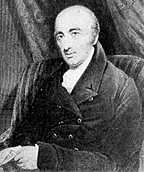 With Lavoisier's new definition of element, each metal became a unique element. Inconsistent metallic properties now seemed more likely due to a combination of similar metals residing in common ores. Platinum was one metal that on occasion had differing properties. In 1803 Dr. William Hyde Wollaston (1766-1828 at right) succeeded in separating two new metals from Platinum. After dissolving crude Platinum in aqua regia, he used mercurous cyanide to precipitate a new metal he called Palladium. Searching for possible additional elements, Wollaston neutralized the aqua regia with caustic soda to remove Platinum and then precipitated the Palladium with mercurous cyanide, thereby removing all the known metals except for Mercury. Wollaston decomposed the excess mercurous cyanide in the remaining filtrate by adding muriatic acid and evaporated it to dryness. When he washed the new residue with alcohol, everything dissolved except a beautiful dark red powder. This proved to be the double chloride of sodium and a new metal. Because of the rose color of its salts, Wollaston named the second new metal Rhodium (Rh = #45): Rhodon (Greek) means rose.
With Lavoisier's new definition of element, each metal became a unique element. Inconsistent metallic properties now seemed more likely due to a combination of similar metals residing in common ores. Platinum was one metal that on occasion had differing properties. In 1803 Dr. William Hyde Wollaston (1766-1828 at right) succeeded in separating two new metals from Platinum. After dissolving crude Platinum in aqua regia, he used mercurous cyanide to precipitate a new metal he called Palladium. Searching for possible additional elements, Wollaston neutralized the aqua regia with caustic soda to remove Platinum and then precipitated the Palladium with mercurous cyanide, thereby removing all the known metals except for Mercury. Wollaston decomposed the excess mercurous cyanide in the remaining filtrate by adding muriatic acid and evaporated it to dryness. When he washed the new residue with alcohol, everything dissolved except a beautiful dark red powder. This proved to be the double chloride of sodium and a new metal. Because of the rose color of its salts, Wollaston named the second new metal Rhodium (Rh = #45): Rhodon (Greek) means rose.
In 1803 a colleague of Wollaston, Smithson Tennant (1761-1815), dissolving platinum in dilute aqua regia, found undissolved black powder. Tennant attempted to alloy the powder with lead and concluded it was likely a new metal. In Paris Collet-Descotils, a friend and pupil of Vauquelin, found this black powder contains a metal which gives a red precipitate with ammoniacal platinum solution. Vauquelin treated the powder with alkali obtaining a volatile oxide. By the Spring of 1804 Tennant concluded that the powder contains two metals which can be separated by alternate action of acid and alkali. One he called osmium because of its odor, and the other he called Iridium (Ir = #77): Iris (Greek meaning rainbow) because its salts show a variety of colors. Iridium is the same as the metal investigated by Collet-Descotils and Vauquelin.
As early as 1758 Marggraf noted that soda colors flames yellow and potash gives a lavender flame. In 1814 the German glass maker and physicist Josef Fraunhofer (1787-1826) made a prism and noted dark lines in the sun's spectrum which he labelled by letters. William Henry Fox Talbot (1800-1877), who pioneered photographic negatives and positives and deciphered Assyrian inscriptions at Nineveh, distinguished red Lithium and Strontium flames using a prism. In 1854 David Alter of Freeport, Pennsylvania, found that each element he studied had its own unique spectrum. Robert Bunsen and Gustav Kirchhoff developed spectroscopic analysis to detect minute concentrations of elements.
Robert Wilhelm Bunsen (1811-1899) was born and educated in Göttingen where he studied chemistry under Stromeyer and earned a doctor of philosophy. Using a government grant, he toured Germany, France, Austria, and Switzerland largely on foot, studying geology, visiting mines and factories, and meeting scientists. In 1836 he succeeded Wöhler teaching at the higher technical school at Cassel, moved on the Marburg, Breslau, and finally to Heidelberg where he taught 38 years until retiring at age 78. His first publication showed that freshly precipitated ferric hydroxide is an antidote to Arsenic poisoning. When working on poisonous cacodyl cyanide he wore a mask with a long tube to fresh air. An explosion shattered the mask, destroyed sight in his right eye, and nearly ended his life. He recovered, finished the study, developed methods for analyzing blast furnace gases, invented the Carbon-Zinc battery, a photometer, a calorimeter, and perfected the Bunsen burner. He accompanied a Danish expedition to Mount Hekla which erupted in 1845 and measured geysers and hot springs in Iceland. Upon returning he carried out photochemical researches with Henry Roscoe, a lifelong friend. He abruptly interrupted that study in 1859 when a collaborator, Gustav Robert Kirchhoff (1824-1887) reproduced a dark spectral line such as Fraunhofer had observed in the sun's spectrum. From Königsberg, Prussia, Kirchhoff had met Bunsen while both taught in Breslau, and came to teach and work with Bunsen in Heidelberg from 1854 to 1875. At Kirchhoff's suggestion they developed a spectroscope that used a lense to focus a flame's light on a prism, then viewed the separated colors using a telescope. When their spectroscope was used to observe a Bunsen burner flame sprinkled with table salt, a yellow line was seen that seemed to exactly matched Fraunhofer's D-line. In an attempt to fill in the dark solar D-line and prove the match, they simultaneously passed both sunlight and the bright yellow Sodium spectra through the spectroscope. But instead of filling in the missing yellow color, the D-line was even darker! Kirchhoff (shown at left) worked overnight, finally discovering that he could reproduce the dark D-line artificially by passing a continuous spectrum through a bright yellow Sodium flame. Apparently the sodium in the flame adsorbed light waves that exactly matched the vibration of Sodium. On 15 November 1859 Bunsen (shown at right) wrote to Roscoe,
Thus a means has been found to determine the composition of the sun and fixed stars with the same accuracy as we determine sulfuric acid, chlorine, etc., with our chemical reagents. Substances on the earth can be determined by this method just as easily as on the sun, so that, for example, I have been able to detect Lithium in 20 grams of sea water.

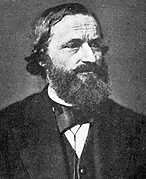
In the Spring of 1860 Bunsen wrote that if one viewed with the flame of a spectroscope a drop of Dürkheim mineral water, one would recognize the light of Sodium, Potassium, Lithium, Calcium, and Strontium. But after precipitating lime, strontia, magnesia, you see the lines of Sodium, Potassium, and Lithium, and in addition, two remarkable blue lines, very close together for which no known substance gives such rays. We propose to give this new metal the name Cesium (symbol Cs) from Caesius (Latin), which the ancients used to designate the blue of the upper part of the firmament. This name seems to us to be justified... by the beautiful blue color of the incandescent vapor of this new element.
(Cs = #55) Twenty years later Carl Setterberg working in Bunsen's laboratory isolated Cesium by electrolysis of the cyanide in the presence of barium cyanide.
On 23 February 1861 Bunsen and Kirchhoff reported that dissolving alkalies from lepidolite from Saxony, followed by precipitation by platinic chloride and repeated washing with boiling water, revealed two new spectral lines of a magnificent violet. Additional washing revealed red, yellow and green lines not belonging to other elements. Among them we may mention two remarkable red lines... located at the extreme red end of the spectrum... (which) led us to give this element the name Rubidium and the symbol Rb from Rubidus (Latin) which, with the ancients, served to designate the deepest red.
(Rb = #37) Bunsen was one of the most modest of men. When necessary to mention his own discoveries, he never said I have discovered
but always said man has found...
Bunsen never married, and when asked, he would say I never could find the time.
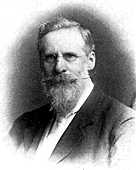 Very soon after Bunsen and Kirchhoff announced the discovery of Rubidium, Sir William Crookes (1832-1919 at right) examined some residues from a sulfuric acid plant at Tilkerode in the Harz. Crookes first published paper at age 19 was on selenocyanides. One of Crookes' college professors had given him the residues because they contained Selenium which could be turned to selenocyanides. Crookes had saved them because he thought they might also contain Tellurium. But on examining the residues with a spectroscope he found no lines of Tellurium, and the lines of Selenium soon faded. But a beautiful green line appeared that he have never previously seen. He concluded the residues must contain a new element. Because of the green color he named it Thallium (Tl = #81): Thallus (Latin) means sprouting green twig. Crookes announced the discovery in the 30 March 1861 Chemical News which he started in 1859 and was the sole editor until 1906. In April 1862 Claude-Auguste Lamy (1820-1878) examined some slime from a sulfuric acid plant at Loos which was using Belgian pyrite and observed the green spectral line. He extracted the Thallium by boiling with aqua regia, diluted with boiling water, then by cooling precipitated yellow thallium sesquichloride. He isolated the metal by electrolysis. After studying compounds of Thallium he concluded the metal forms +1 and +3 valence.
Very soon after Bunsen and Kirchhoff announced the discovery of Rubidium, Sir William Crookes (1832-1919 at right) examined some residues from a sulfuric acid plant at Tilkerode in the Harz. Crookes first published paper at age 19 was on selenocyanides. One of Crookes' college professors had given him the residues because they contained Selenium which could be turned to selenocyanides. Crookes had saved them because he thought they might also contain Tellurium. But on examining the residues with a spectroscope he found no lines of Tellurium, and the lines of Selenium soon faded. But a beautiful green line appeared that he have never previously seen. He concluded the residues must contain a new element. Because of the green color he named it Thallium (Tl = #81): Thallus (Latin) means sprouting green twig. Crookes announced the discovery in the 30 March 1861 Chemical News which he started in 1859 and was the sole editor until 1906. In April 1862 Claude-Auguste Lamy (1820-1878) examined some slime from a sulfuric acid plant at Loos which was using Belgian pyrite and observed the green spectral line. He extracted the Thallium by boiling with aqua regia, diluted with boiling water, then by cooling precipitated yellow thallium sesquichloride. He isolated the metal by electrolysis. After studying compounds of Thallium he concluded the metal forms +1 and +3 valence.

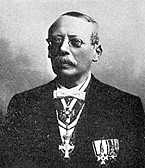 Ferdinand Reich (1799-1882 at left), professor of physics and inspector at the Freiberg School of Mines, began a search for Thallium in local Zinc ores. After roasting the blende to remove Sulfur and Arsenic, he decomposed it with hydrochloric acid. By 1863 he had obtained a straw-yellow precipitate which he described as the sulfide of a new element. Because he was colorblind, he had his assistant Hieronymus Theodor Richter (1824-1898 at right), the school metallurgical chemist, do the spectroscopic examination. Richter placed some of the material on a loop of platinum wire and heated it with a Bunsen burner. Richter observed a brilliant indigo line which did not correspond to any known element. Because of this characteristic indigo blue emission spectral line, the new element was called Indium (In = #49): Indicum (Latin) means indigo. The pigment indigo was named after indicon (Greek) in allusion for its coming from India. Reich and Richter found it easier to isolated Indium from zinc rather than the original blende. They reduced indium oxide in a current of hydrogen gas and melted the metal under potassium cyanide. At the suggestion of Reich, Clemens Winkler made a thorough study of the metal and its compounds.
Ferdinand Reich (1799-1882 at left), professor of physics and inspector at the Freiberg School of Mines, began a search for Thallium in local Zinc ores. After roasting the blende to remove Sulfur and Arsenic, he decomposed it with hydrochloric acid. By 1863 he had obtained a straw-yellow precipitate which he described as the sulfide of a new element. Because he was colorblind, he had his assistant Hieronymus Theodor Richter (1824-1898 at right), the school metallurgical chemist, do the spectroscopic examination. Richter placed some of the material on a loop of platinum wire and heated it with a Bunsen burner. Richter observed a brilliant indigo line which did not correspond to any known element. Because of this characteristic indigo blue emission spectral line, the new element was called Indium (In = #49): Indicum (Latin) means indigo. The pigment indigo was named after indicon (Greek) in allusion for its coming from India. Reich and Richter found it easier to isolated Indium from zinc rather than the original blende. They reduced indium oxide in a current of hydrogen gas and melted the metal under potassium cyanide. At the suggestion of Reich, Clemens Winkler made a thorough study of the metal and its compounds.
Other new elements were also revealed by the spectroscope: Gallium, Helium, Ytterbium, Holmium, Thulium, Samarium, Neodymium, Praseodymium, and Lutecium.
![]()

| introduction | alchemy | planets | other celestial objects | other properties | myths | people | minerals | ore mines | other places | combination names |
| to site menu | Introduction to Development of Periodic Chart |
18th Century vocabulary, & index of people |
chemistry | physics | ||||||
| created 31 December 2000, amplified 25 May 2001 minor revision 16 June 2007 |
by D Trapp | |||||||||